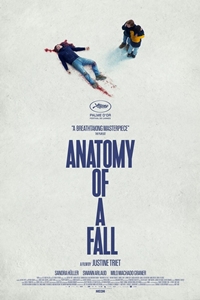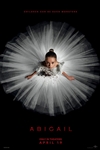Anatomy of a Fall (R) ★★★½
 Anatomy of a Fall is an uncommonly perceptive and thought-provoking procedural. Because the movie transpires in France and works using the rules of French jurisprudence, it is better able to address questions of truth than a U.S.-based iteration of the same story would be able to do. (The case would never make it in front of a judge in an American court.) By focusing on the narrative that emerges during a trial rather than the events of what happened at the chalet shared by wife Sandra Voyter (Sandra Huller), husband Samuel Maleski (Samuel Theis), and their son, Daniel (Milo Machado Graner), Anatomy of a Fall can ponder the unknowability of any objective truth. It's another facet of the Rashomon prism.
Anatomy of a Fall is an uncommonly perceptive and thought-provoking procedural. Because the movie transpires in France and works using the rules of French jurisprudence, it is better able to address questions of truth than a U.S.-based iteration of the same story would be able to do. (The case would never make it in front of a judge in an American court.) By focusing on the narrative that emerges during a trial rather than the events of what happened at the chalet shared by wife Sandra Voyter (Sandra Huller), husband Samuel Maleski (Samuel Theis), and their son, Daniel (Milo Machado Graner), Anatomy of a Fall can ponder the unknowability of any objective truth. It's another facet of the Rashomon prism.
Recognizing that images captured by the camera represent something concrete, director Justine Triet is careful about deciding what to show on-screen. The instance of death is never depicted; we see precursor moments and are by Daniel's side when he discovers the body but the minutia surrounding the actual death is left for the lawyers to argue. And, because she wants to emphasize the elusive nature of an objective truth, Triet rejects a facile omniscient representation of the death-scene at any point.
The dead body belongs to Samuel, who apparently falls from the third-floor window of his chalet at the base of the French Alps. Questions accompany the discovery of the body. Did Samuel fall, commit suicide, or was he pushed by the only other person in the house at the time, Sandra? Is a blood spatter pattern the result of the impact of the body with an object while falling or the result of his being struck across the head with a blunt object? Sandra believes it was suicide. The police, suspecting foul play, begin to build a case against Sandra, causing her to solicit advice from an old friend, lawyer Vincent Renzi (Swann Arlaud).
It's probably no coincidence that the title, Anatomy of a Fall, recalls Otto Preminger's classic, Anatomy of a Murder. A courtroom thriller, the 1959 film was often praised for its emphasis on investigation and trial procedures over melodrama and surprise revelations. Plot-wise, Anatomy of a Fall has no similarities with Anatomy of a Murder but both focus on process. In a situation where the scant forensic evidence is contradictory and inconclusive, the cause of death in Anatomy of a Fall becomes a question of witness reliability and perspective. Triet gives us a verdict but at no point does she equate the verdict with truth. At one point, when Daniel questions what to believe about his mother, he is advised that he should make a "decision" about what he thinks the truth is. The decision is influenced more by faith than facts. (And it makes us wonder about the veracity of his testimony, which could easily be a fabrication.)
Anatomy of a Fall lacks a genuine antagonist, so the prosecutor played by Antoine Reinartz fills the role. With dogged tenacity, he goes after Sandra's testimony, seeking to shred it, thereby ruining her credibility and validating the prosecution's case that she hit her husband over the head and pushed him from the third-floor window. Because the movie's perspective naturally aligns the viewer with Sandra, we see the prosecutor as overzealous but he fulfills the important role of calling into question Sandra's story. Without this counterbalance, Anatomy of a Fall would be a plodding chronicle of a police investigation and its aftermath.
The film won the prestigious Palm D'Or at the 2023 Cannes Film Festival. Considering the festival's penchant for doling out citations to pretentious tripe, that's not always a ringing endorsement, but this is an instance when an exceptional film received deserved attention. To Americans, many things that happen during the course of Sandra's trial may seem odd owing to the differences in how evidence and testimony are handled in French courts. As I mentioned earlier, this case wouldn't make it to trial under U.S. law where a key piece of evidence would be thrown out and most of the testimony would be deemed inadmissible as hearsay.
The strength of Anatomy of a Fall comes from its willingness to embrace ambiguity and a lack of closure in ways that intrigue (rather than frustrate) the viewer. Although the movie could easily be mistaken for a whodunnit, we gradually learn that the least interesting element of the story to Triet is the death. That influences her approach to events, resulting in a more satisfying conclusion even though the resolution lacks a firm, unassailable answer.
© 2023 James Berardinelli
To get the full Quicklook Films experience, uncheck "Enable on this Site" from Adblock Plus
box office top 10

Challengers Released: April 26, 2024 Cast: Zendaya, Josh O'Connor 15M

Unsung Hero Released: April 26, 2024 Cast: Daisy Betts, Joel Smallbone 7.8M

Godzilla x Kong: The New Empire Released: March 29, 2024 Cast: Rebecca Hall, Brian Tyree Henry 7.2M

Civil War Released: April 12, 2024 Cast: Kirsten Dunst, Wagner Moura 7M

Abigail Released: April 19, 2024 Cast: Melissa Barrera, Dan Stevens 5.3M

The Ministry of Ungentlemanly Warfare Released: April 19, 2024 Cast: Henry Cavill, Eiza Gonzalez 3.9M

Kung Fu Panda 4 Released: March 8, 2024 Cast: Jack Black, Viola Davis 3.6M

Ghostbusters: Frozen Empire Released: March 22, 2024 Cast: Paul Rudd, Carrie Coon 3.3M

Dune: Part Two Released: March 1, 2024 Cast: Timothée Chalamet, Rebecca Ferguson 2M

Boy Kills World Released: April 26, 2024 Cast: Bill Skarsgård, Famke Janssen 1.7M






